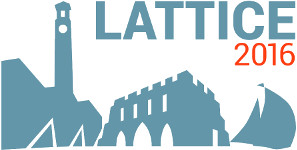Speaker
Dr
Benoît Blossier
(CNRS/LPT Orsay)
Description
In many lattice simulations with dynamical quarks, radial or orbital
excitations of hadrons lie near multihadron thresholds: it makes the
extraction of excited states properties more challenging and cqn introduce
some systematics difficult to estimate without an explicit computation of
correlators using interpolating fields strongly coupled to multihadronic
states. In a recent study of the strong decay of the first radial excitation
of the $B^*$ meson, this issue has been investigated and we have clues that
a diquark interpolating field $\bar{b} \gamma^i q$ is very weakly coupled to a
$B \pi$ $P$-wave state while the situation is quite different if we consider an
interpolating field of the kind $\bar{b} \nabla^i q$, where $\vec{\nabla}$ is a
covariant derivative: those statements are based on examining the charge
density distribution.
Author
Dr
Benoît Blossier
(CNRS/LPT Orsay)
Co-author
Dr
Antoine Gérardin
(University of Mainz)

